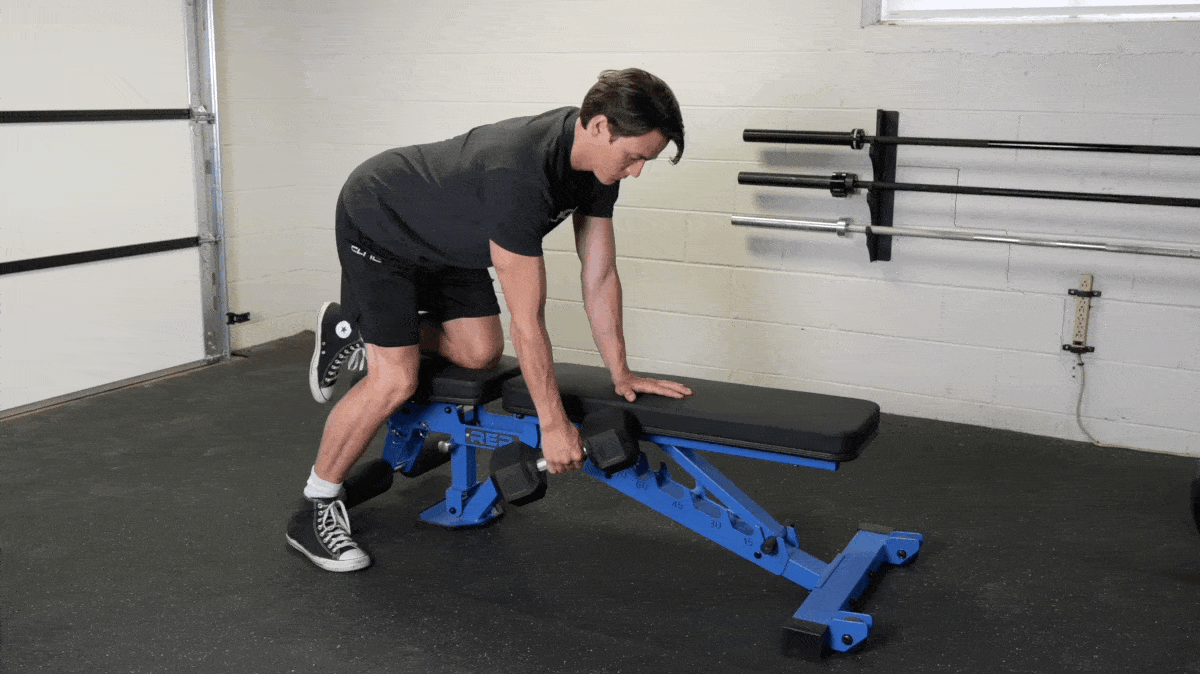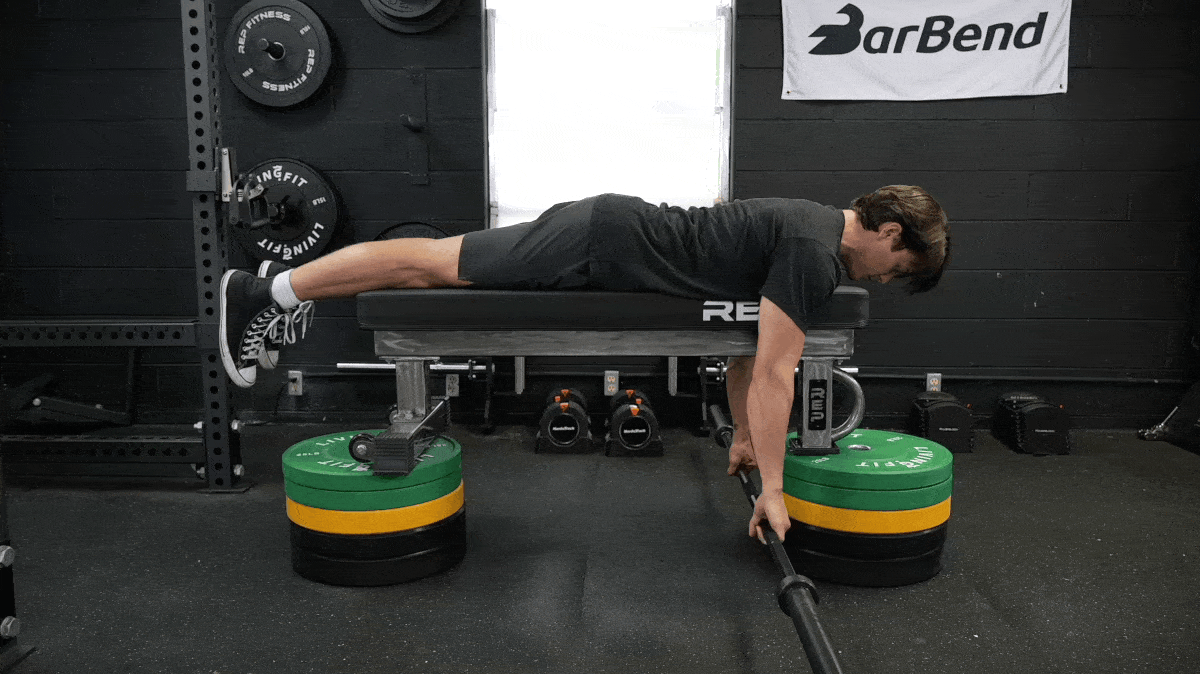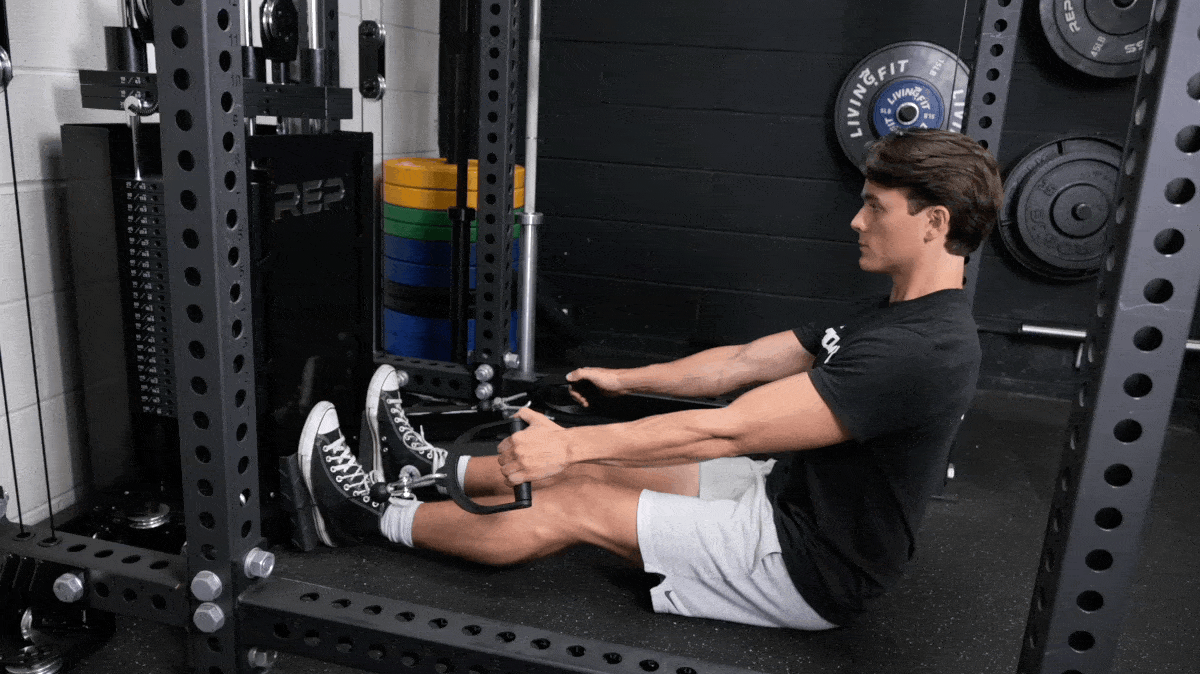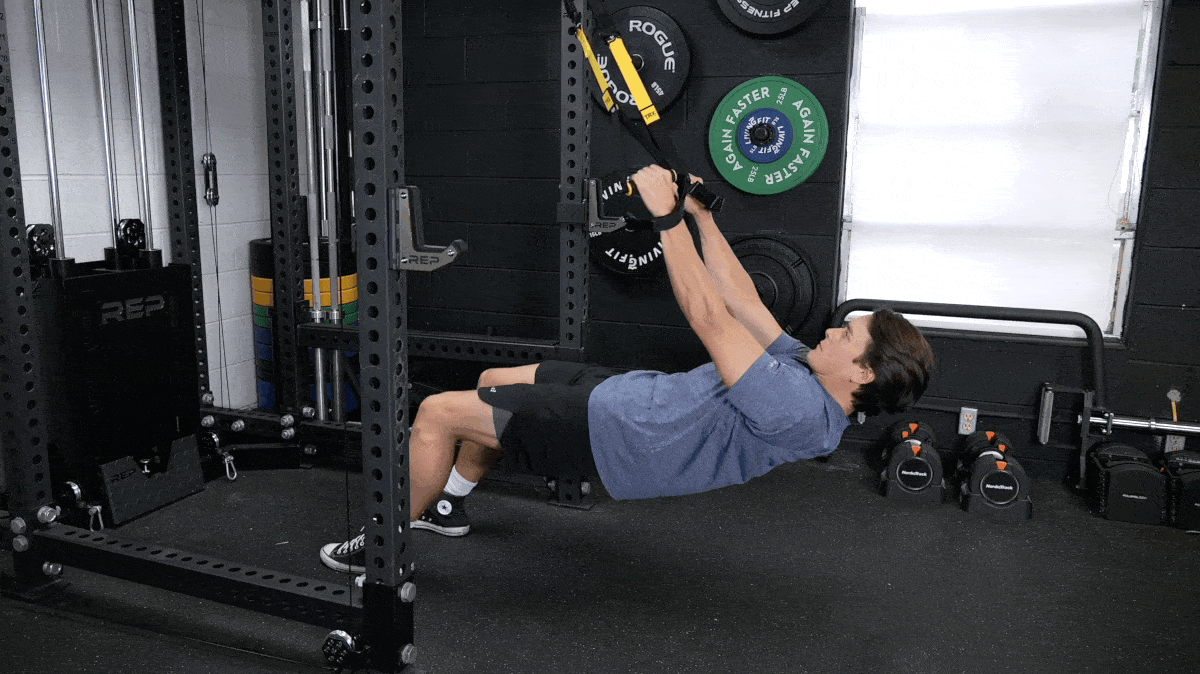Have you ever wanted to be so broad that you need to turn sideways to enter or exit an elevator? Do you want to finally achieve that iconic X-frame look that all bodybuilders aspire to? Maybe your desires are a bit more pedestrian; you want to strengthen your back to get through those around-the-house chores that take a bit more of a toll than they should.
No matter your “why,” the “what” is the same — you need bigger, stronger, lats to improve your aesthetics and perform better both in and out of the weight room.

But not all lat exercises are created equal. Some are patently more effective than others, and knowing where to direct your time and effort is critical if you want to grow and strengthen your back. These are the 10 best lat exercises and lat-focused back workouts that’ll leave you feeling like you can fly out of the gym.
10 Best Lat Exercises
- Dumbbell Row
- Barbell Row
- Hammer Strength Row
- Weighted Chin-Up
- Seal Row
- Close-Grip Pulldown
- Seated Cable Row
- Straight-Arm Pulldown
- Dumbbell Pullover
- TRX Inverted Row
1. Dumbbell Row
Your lats serve one primary function above others; bringing your arm into your torso. Whether you row crew professionally or hit the gym to beef up your upper back, a lot of rowing is mandatory if you want to grow or strengthen your lats.

[Read More: Try These Dumbbell Shoulder Workouts to Build Strength, Size, or Get Flexible]
The dumbbell row shines here as a classic lat-builder. As a unilateral exercise, the dumbbell row allows you to target each of your lats individually, preventing any imbalances in muscle or strength that may occur. Dumbbell rows also let you work with pretty heavy weights; consider using a pair of lifting straps if you’re really pushing it.
How to Do It
- Lay a moderate to heavy dumbbell beside a weight bench and place the knee opposite your working arm onto the bench. Plant your non-working palm on the bench as well.
- Firmly “spike” your back foot into the floor behind you or out to the side. Brace your core.
- Reach down with your working arm and grab the dumbbell, then take a deep belly breath.
- Row the dumbbell up until your upper arm is parallel with your torso, then lower it slowly back down without letting it touch the floor again.
Coach’s Tip: Avoid twisting your torso as you perform the dumbbell row. Keep your trunk perpendicular to the floor and “squared up” without tilting to one side.
Sets and Reps: Do 3 or 4 sets of 6 to 9 repetitions on this one.
2. Barbell Row
The barbell row offers a more comprehensive stimulus than the dumbbell row. While that does mean slightly less lat engagement specifically, rowing with a barbell provides a whole host of different benefits to your posterior chain.
[Read More: Learn to Do The Incline Barbell Bench Press For A More Complete Chest]
Barbell rows require you to maintain a rock-solid hip hinge and a snugly-braced core; no leaning against a bench allowed. As such, you’ll get some extra lower back work in for free while still hammering your lats with pretty heavy weights.
How to Do It
- Stand upright with your feet under your hips, holding a barbell with a double-overhand or double-underhand grip.
- Inhale and perform a hip hinge, tipping over and allowing the bar to glide down until it hangs just below your kneecap.
- From here, brace your core; your torso should be parallel-ish to the floor.
- Hold your air and row the barbell up toward your lower abdomen.
Coach’s Tip: The more you tip over, the harder the barbell row becomes. You can play with your torso angle to find what’s comfortable but don’t hold yourself any more upright than 45 degrees.
Sets and Reps: Try 3 to 5 sets of 5 to 8 reps on the barbell row for lat strength.
3. Hammer Strength Row
Machines shouldn’t necessarily make up the bulk of your workout routine. That said, the right exercise machine can provide a unique stimulus you can’t always get from free weights — specifically because they aren’t constrained by gravity.
[Read More: How to Do the Pendlay Row for Back Size and Stronger Lifts]
The Hammer Strength row machine shines for lat development for exactly this reason. It offers you a plate-loaded horizontal pulling movement with a lot of inherent stability so you can focus on what matters; crushing your lats with each and every rep.
How to Do It
- Load the pegs with moderate to heavy weight and adjust the seat such that your upper chest rests comfortably against the torso pad when you’re sitting.
- Grab either the overhand handle or the neutral-grip handle, brace your core, and actively pull your chest against the torso pad.
- Then, row the handles toward your body by retracting your shoulders and driving backward with your elbows.
Coach’s Tip: The Hammer Strength row works well as a unilateral exercise if you want to use each arm separately.
Sets and Reps: Go for 4 sets of 12 to 15 reps here.
4. Weighted Chin-Up
Chin-ups can be a frustrating exercise. If you can’t do one properly, they can feel insurmountably difficult. But once you get your first one, every subsequent rep comes a little easier. Once you can bang out 15 or 20 unbroken chins, it can be difficult to keep getting value out of the exercise.
[Read More: 12 Best Greens Powder , RDN-Approved]
Throw some extra weight into the mix, though (such as hanging some weight plates from a dip belt or clinching a dumbbell between your ankles), and the chin-up becomes a different beast. Performing weighted chin-ups provides an element of consistent, progressive overload to your lats, and will challenge your core a bit more as well.
How to Do It
- Attach a weight plate to a dip belt or wrap a small dumbbell between your ankles and then hop up to a pull-up bar with a shoulder-width, underhand grip.
- Allow yourself to hang fully from the bar with your shoulders up by your ears.
- Inhale, brace your core, and pull yourself up by depressing your shoulders and driving your elbows downward until your chin clears the bar.
Coach’s Tip: Think about putting your elbows into your back pockets to engage your lats.
Sets and Reps: Work up to multiple sets of weighted chin-ups leaving two reps in the tank each time.
5. Seal Row
The seal row makes up for almost all of the potential “drawbacks” of the barbell row. Chiefly, that your lumbar spine and hips need to work overtime to maintain a good hinge while you row.

[Read More: 16 Best Creatine Supplements (Personally Tested)]
This saps you of energy that you could otherwise be directing at your lats. By lying prone on a flat bench, you can replicate the exact same posture of a barbell row without any load on your lower back. As such, you can expect much higher lat activation.
How to Do It
- You’ll need a flat bench with plenty of space underneath here; place the legs of the bench onto a pair of step-up platform, plyo boxes, or bumper plates.
- Lie prone on the bench with a loaded barbell underneath and grab it with a double-overhand grip.
- Initiate the row by pulling the bar up and inward until your upper arms come aligned with your torso.
Coach’s Tip: The setup is the most difficult part of this exercise. Make sure you have enough room under the bench to row with a full range of motion.
Sets and Reps: Try 3 to 4 sets of 12 to 15 reps with the seal row.
6. Close-Grip Pulldown
Cable exercises like the close-grip pulldown are among your most valuable tools when it comes to targeting your lats. Mainly because they let you circumvent the downward-only force of gravity, but additionally due to the consistent mechanical tension provided by the cable itself.
[Read More: The 18 Best Pre-Workouts, RDN-Approved (Personally Tested)]
Benefits of the close-grip pulldown include: The handle aligns nicely with the fibers of your lats for maximum muscular activation, the thigh pad helps you stay secure and stable, and you can find a lat pulldown station in just about every gym on Earth.
How to Do It
- Adjust the weight of a lat pulldown station until it is moderately heavy and then fix a close-grip handle to the carabiner.
- Sit down into the lat pulldown station, gripping the handles with each hand and firmly fixing your thighs against the pad.
- Lean back very slightly and pull the cable downward, driving your elbows into your back pockets and squeezing your shoulders together at the bottom.
Coach’s Tip: Keep your upper arms tucked tightly to your sides as you pull.
Sets and Reps: Try 3 sets of 10 reps at first.
7. Seated Cable Row
Your lats are specifically designed to help you pull an object toward your body. This makes any row variation a potential pathway for growth and strength. The upright, seated cable row with a narrow or neutral grip is, debatably, your best option in some cases.

[Read More: 11 Lat Pulldown Variations for a Stronger, Wider Back]
This rowing movement offers lots of flexibility regarding setup and execution. You can use a few different row grips to find your optimal line of pull and get some serious mind-muscle connection going.
How to Do It
- Take a seat on the row station and grab the handles with a close, neutral grip.
- Scoot back on the bench to pull the cable taut. Allow the weight to pull your shoulders forward while you sit upright with a braced core.
- Row the handle (or handles) toward your body, pulling your elbows down and backward.
Coach’s Tip: You can perform this exercise bilaterally or with one arm at a time, depending on your preference.
Sets and Reps: Bang out 4 sets of 12 reps for a serious lat pump.
8. Straight-Arm Pulldown
Your lats are a pair of large, powerful muscles; they’re actually the largest individual muscles in your upper body. So while they do have a lot of power potential for heavy lifting, if you want the most back gains possible you shouldn’t be afraid to incorporate some isolation work as well.
[Read More: The 5 Best Lower Lat Exercises for a Denser Back]
The straight-arm pulldown is downright invaluable for isolating your lats. It forces you to perform arm exercises— the primary function of your lats — while limiting biceps and trapezius recruitment. The pump from this one is gnarly, too.
How to Do It
- Set an adjustable cable to about eye level and attach a straight bar or rope to the carabiner.
- Grab the attachment and take about two steps backward so the cable pulls taut off the stack.
- Your arms should be straight and extended out in front of you, roughly perpendicular to your torso.
- From here, brace your core and pull the attachment you’re holding down toward your hips without bending your elbows.
Coach’s Tip: Think about sweeping the weight down and into your legs. Keep your elbows nearly locked.
Sets and Reps: Crank out 2 or 3 sets of 15 repetitions for a serious lat pump.
9. Dumbbell Pullover
Some exercises, like the dumbbell pullover, stand the test of time. The pullover has been a back-building staple since the golden era of competitive bodybuilding.
The dumbbell pullover is not only a stellar lat-building exercise, but it’s also one of the very few movements you can do to target both your back and your chest simultaneously. It’s also accessible and has a straightforward, easy-to-learn technique.
How to Do It
- Grab a dumbbell and sit on the end of a weight bench.
- Sit back and lie down on the bench. Hold the insides of one end of the dumbbell in your palms with your arms extended directly upward, elbows straight.
- From here, gradually lower the dumbbell back behind your head without bending your elbows.
- Once your arms are parallel to your torso (if your shoulder mobility permits), reverse the motion and contract your lats to bring the dumbbell back to the starting position.
Coach’s Tip: Plant your feet on the ground for more stability, or you can hold them cross-legged in the air to train your core as well.
Sets and Reps: Try 2 or 3 sets of 15 to as many as 20 repetitions.
10. TRX Inverted Row
TRX suspension systems aren’t just for beginners in the gym. Heavy weights certainly have their place, but you can incorporate certain bodyweight exercises into your back workouts and make stellar gains with them.

[Read More: How to Do the Dumbbell Pullover for a Bigger Back and Chest]
The inverted row is a surprisingly effective lat exercise. When you perform it with a pair of TRX handles instead of using a fixed bar, you afford yourself more freedom of movement and can tweak your setup in real-time to optimize your form.
How to Do It
- Lengthen the TRX straps until they hang about three feet off the ground.
- Grab one handle in each hand, brace your core, and gradually move into a plank position while hanging from the TRX system.
- Your torso should be locked and rigid, suspended a few inches off the ground.
- From here, “row” yourself upward by contracting your lats and pulling your elbows in toward your torso.
Coach’s Tip: The more horizontal you are in the starting position, the harder the exercise will be.
Sets and Reps: Try 3 or 4 sets of 12 to 15 repetitions.
Lats Warm-Up
Properly warming up for a lat-focused back workout can make the difference between an average workout and an exceptional one. While you may not need to go through an extensive mobilization sequence, there are still some steps you can take to prime yourself for top-tier performance:
- 5 to 10 minutes of low-intensity cardio on the treadmill, exercise bike, stair-climber, or elliptical.
- 2 to 3 warm-up sets of 15 to 20 reps with a very light weight of your first exercise.
- One final primer set of 5 to 6 reps with a moderate weight before your first working set.
3 Lat Workouts to Try
You can’t really design, program, and perform a “lat-only” workout; doing so would severely limit your exercise selection. However, you can certainly run through a back workout that both addresses your specific goals and heavily emphasizes the lats.
Lat Workout for Beginners
As a beginner, you should find your lats getting bigger and stronger no matter which back exercises you perform. Your task, then, is to master your technique with simple, reliable exercises that will set you up for long-term success on your fitness journey.
- Barbell Row: 3 x 6
- Assisted Chin-Up: 2 sets to failure
- Face Pull: 2 x 15-20
Lat Workout for Bodybuilding
To blow up your lats, you need to maximize your muscular hypertrophy. This means picking the right movements, establishing a rock-solid mind-muscle connection, and going to town.

[Read More: Learn Rack Pulls for More Pulling Strength and a Bigger Back]
Bodybuilding back workouts are all about utilizing different types of equipment and taking yourself to the brink of — and sometimes beyond — muscular failure through high-intensity training.
- Dumbbell or Seal Row: 4 x 8-10
- Close-Grip Pulldown or Seated Cable Row: 3 x 12-15
- Straight-Arm Pulldown or Dumbbell Pullover: 2 x 20
- Assisted Chin-Up: 2 sets to failure
Lat Workout for Strength
A strong back is good for more than helping you set new 1-rep maxes in the gym or on the powerlifting platform. Strong lats help you perform better in sports and general physical activity as well. There’s no need to get too fancy with your training if you’re prioritizing strength. Prioritize work ethic instead and you’ll get there.
- Weighted Chin-Up: 4 sets at an RPE of 8 to 8.5
- Barbell or Pendlay Row: 3 x 8-10
- Dumbbell Pullover: 3 x 15
Anatomy of the Lats
Your “lats” are short for latissimus dorsi; two large, fan-shaped muscles that sit on each side of the back of your torso. They are the largest individual muscles in your upper body and have a tremendous amount of fatigue tolerance and power output potential.
The latissimus dorsi originate all along the spine and primarily connect to your humerus, or your upper arm bone. As such, they contribute toward humeral extension when you bring your arm in line with your body during a row, pulldown, or pull-up.
More Training Content
- How Many Sets Per Muscle Group, Per Week, Should You Do?
- How To Lose Belly Fat — A Strength Athlete’s Guide
- The 17 Best Glute Exercises, Chosen by Experts
Featured Image: Satyrenko / Shutterstock
The post The 10 Best Lat Exercises for Growth and Strength (Expert Approved) appeared first on BarBend.
